Ferroelectric and Ferroelastic Domain Related Formation and Influential Mechanisms of Vapor Deposited Piezoelectric Thin Films
Abstract
1. Introduction
2. Energy Associated Nucleation and Formation Mechanisms
2.1. Variation of Growth Modes
2.2. Formation Mechanisms of Misfit Dislocations
2.3. Formation Mechanisms of Domain Structures
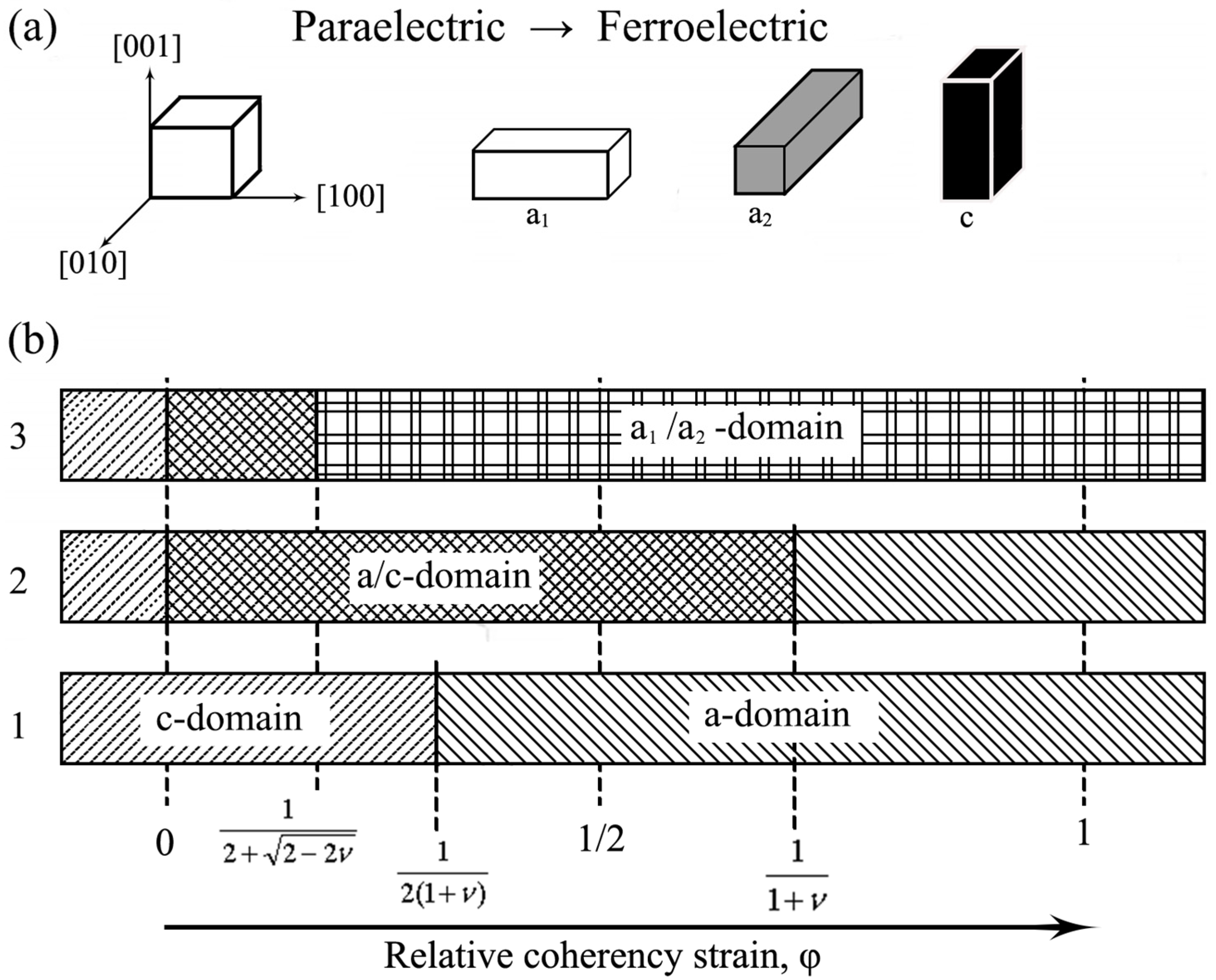
2.4. Domain Configurations in Tetragonal PTFs
3. Influence of Film/Substrate System on Domain Structures
3.1. Substrates Characteristics
3.2. PTF Characteristics
3.3. Electrode Film Characteristics
4. Influence of External Stimuli on Domain Structures
4.1. Influence of External Electric Field on Domain Structures
4.2. Influence of External Mechanical Stress on Domain Structures
5. Summary and Prospects
Author Contributions
Funding
Institutional Review Board Statement
Informed Consent Statement
Data Availability Statement
Conflicts of Interest
References
- Chapman, D.W. Some thin-film properties of a new ferroelectric composition. J. Appl. Phys. 1969, 40, 2381–2385. [Google Scholar] [CrossRef]
- Khan, A.; Abas, Z.; Soo Kim, H.; Oh, I.K. Piezoelectric thin films: An integrated review of transducers and energy harvesting. Smart Mater. Struct. 2016, 25, 05032. [Google Scholar] [CrossRef]
- Arndt, R.E.A.; Paul, S.; Ellis, C.R. Application of Piezoelectric Film in Cavitation Research. J. Hydraul. Eng. 1997, 123, 539–548. [Google Scholar] [CrossRef]
- Francombe, M.H. Ferroelectric films and their device applications. Thin Solid Film. 1972, 13, 413–433. [Google Scholar] [CrossRef]
- Setter, N.; Damjanovic, D.; Eng, L.; Fox, G.; Gevorgian, S.; Hong, S.; Kingon, A.; Kohlstedt, H.; Park, N.Y.; Stephenson, G.B.; et al. Ferroelectric thin films: Review of materials, properties, and applications. J. Appl. Phys. 2006, 100, 51606. [Google Scholar] [CrossRef]
- Talin, A.A.; Smith, S.M.; Voight, S.; Finder, J.; Eisenbeiser, K.; Penunuri, D.; Yu, Z.; Fejes, P.; Eschrich, T.; Curless, J.; et al. Epitaxial PbZr0.52Ti0.48O3 films on SrTiO3/(001)Si subsubstrates deposited by sol-gel method. Appl. Phys. Lett. 2002, 81, 1062–1064. [Google Scholar] [CrossRef]
- Zhou, J.; Demiguel-Ramos, M.; Garcia-Gancedo, L.; Iborra, E.; Olivares, J.; Jin, H.; Luo, J.K.; Elhady, A.S.; Dong, S.R.; Wang, D.M.; et al. Characterisation of aluminium nitride films and surface acoustic wave devices for microfluidic applications. Sens. Actuators B Chem. 2014, 202, 984–992. [Google Scholar] [CrossRef]
- Scott, J.F. New developments on FRAMs: [3D] structures and all-perovskite FETs. Mater. Sci. Eng. B Solid-State Mater. Adv. Technol. 2005, 120, 6–12. [Google Scholar] [CrossRef]
- Kang, Y.S.; Fan, Q.; Xiao, B.; Alivov, Y.I.; Xie, J.; Onojima, N.; Cho, S.J.; Moon, Y.T.; Lee, H.; Johnstone, D.; et al. Fabrication and current-voltage characterization of a ferroelectric lead zirconate titanate/ AlGaN/GaN field effect transistor. Appl. Phys. Lett. 2006, 88, 338–383. [Google Scholar] [CrossRef]
- Ali, W.R.; Prasad, M. Piezoelectric MEMS based acoustic sensors: A review. Sens. Actuators A Phys. 2020, 301. [Google Scholar] [CrossRef]
- Noda, M.; Nomura, T.; Popovici, D.; Murakami, S.; Okuyama, M. A highly-sensitive Ba(Ti1−xSnx)O3 thin film dielectric bolometer for uncooled IR sensor. Integr. Ferroelectr. 2004, 63, 35–40. [Google Scholar] [CrossRef]
- Uchino, K. Ferroelectric Devices; Marcel Dekker: New York, NY, USA, 2018; ISBN 9781439803769. [Google Scholar]
- Thapliy, R.; Okano, Y.; Nakamura, S. Electrooptic characteristics of thin-film PLZT waveguide using ridge-type mach-Zehnder modulator. J. Light. Technol. 2003, 21, 1820–1827. [Google Scholar] [CrossRef]
- Qin, W.; Li, T.; Li, Y.; Qiu, J.; Ma, X.; Chen, X.; Hu, X.; Zhang, W. A high power ZnO thin film piezoelectric generator. Appl. Surf. Sci. 2016, 364, 670–675. [Google Scholar] [CrossRef]
- Sahu, M.; Hajra, S.; Lee, K.; Deepti, P.; Mistewicz, K.; Kim, H.J. Piezoelectric nanogenerator based on lead-free flexible pvdf-barium titanate composite films for driving low power electronics. Crystals 2021, 11, 85. [Google Scholar] [CrossRef]
- Miao, J.; Yuan, J.; Wu, H.; Yang, S.B.; Xu, B.; Cao, L.X.; Zhao, B.R. Crystal orientation dependence of the dielectric properties for epitaxial BaZr0.15Ti0.85O3 thin films. Appl. Phys. Lett. 2007, 90, 022903. [Google Scholar] [CrossRef]
- Ouyang, J.; Ramesh, R.; Roytburd, A.L. Theoretical Predictions for the Intrinsic Converse Longitudinal Piezoelectric Constants of Lead Zirconate Titanate Epitaxial Films. Adv. Eng. Mater. 2005, 7, 229–232. [Google Scholar] [CrossRef]
- Jin, L.; He, Z.; Damjanovic, D. Nanodomains in Fe3+-doped lead zirconate titanate ceramics at the morphotropic phase boundary do not correlate with high properties. Appl. Phys. Lett. 2009, 95, 2059–2421. [Google Scholar] [CrossRef]
- Li, Z.; Wang, Y.; Tang, Y.; Zhao, X.; Wang, T.; Duan, Z.; Wang, F.; Li, X.; Leung, C.M.; Fang, B. Growth and electrical properties of high-Curie point rhombohedral Mn-Pb(In1/2Nb1/2)O3-Pb(Mg1/3Nb2/3)O3-PbTiO3 thin films. J. Am. Ceram. Soc. 2021, 104, 313–321. [Google Scholar] [CrossRef]
- Jin, L.; Porokhonskyy, V.; Damjanovic, D. Domain wall contributions in Pb (Zr,Ti) O3 ceramics at morphotropic phase boundary: A study of dielectric dispersion. Appl. Phys. Lett. 2010, 96, 242902. [Google Scholar] [CrossRef]
- Sando, D.; Barthélémy, A.; Bibes, M. BiFeO3 epitaxial thin films and devices: Past, present and future. J. Phys. Condens. Matter 2014, 26, 473201. [Google Scholar] [CrossRef]
- Cao, Y.; Shen, J.; Randall, C.; Chen, L.Q. Effect of multi-domain structure on ionic transport, electrostatics, and current evolution in BaTiO3 ferroelectric capacitor. Acta Mater. 2016, 112, 224–230. [Google Scholar] [CrossRef]
- Lahoche, L.; Lorman, V.; Rochal, S.B.; Roelandt, J.M. Model of the plane laminar PbTiO3 thin film domain structure on MgO substrate. J. Appl. Phys. 2003, 93, 6238–6247. [Google Scholar] [CrossRef]
- Liu, H.; Chen, J.; Huang, H.; Fan, L.; Ren, Y.; Pan, Z.; Deng, J.; Chen, L.Q.; Xing, X. Role of Reversible Phase Transformation for Strong Piezoelectric Performance at the Morphotropic Phase Boundary. Phys. Rev. Lett. 2018, 120, 055501. [Google Scholar] [CrossRef] [PubMed]
- Nakashima, S.; Fujisawa, H.; Kobune, M.; Shimizu, M.; Kotaka, Y. Growth and local structure of BiFeO3 thin films with giant tetragonality on SrRuO3-buffered SrTiO3(001) substrate by ion beam sputtering. Jpn. J. Appl. Phys. 2014, 53, 05FE05. [Google Scholar] [CrossRef]
- Zhu, K.; Wu, S.; Song, B.; Ge, G.; Shi, Y.; Xu, L.; Yan, H.; Shen, B.; Zhai, J. Multi-domain BNiT modification enhanced the piezoelectric properties of BNT-based lead-free thin films. J. Mater. Chem. C 2020, 8, 17114–17121. [Google Scholar] [CrossRef]
- Kim, D.J.; Maria, J.P.; Kingon, A.I.; Streiffer, S.K. Evaluation of intrinsic and extrinsic contributions to the piezoelectric properties of Pb(Zr1-XTX)O3 thin films as a function of composition. J. Appl. Phys. 2003, 93, 5568–5575. [Google Scholar] [CrossRef]
- Ghosh, D.; Sakata, A.; Carter, J.; Thomas, P.A.; Han, H.; Nino, J.C.; Jones, J.L. Domain wall displacement is the origin of superior permittivity and piezoelectricity in BaTiO3 at intermediate grain sizes. Adv. Funct. Mater. 2014, 24, 885–896. [Google Scholar] [CrossRef]
- Trolier-McKinstry, S.; Gharb, N.B.; Damjanovic, D. Piezoelectric nonlinearity due to motion of 180° domain walls in ferroelectric materials at subcoercive fields: A dynamic poling model. Appl. Phys. Lett. 2006, 88, 1235–1788. [Google Scholar] [CrossRef]
- Roytburd, A.L.; Ouyang, J.; Artemev, A. Polydomain structures in ferroelectric and ferroelastic epitaxial films. J. Phys. Condens. Matter 2017, 29, 163001. [Google Scholar] [CrossRef]
- Ouyang, J.; Zhang, W.; Alpay, S.P.; Roytburd, A.L. Effect of elastic domains on electromechanical response of epitaxial ferroelectric films with a three-domain architecture. J. Adv. Ceram. 2013, 2, 1–10. [Google Scholar] [CrossRef]
- Bühlmann, S.; Dwir, B.; Baborowski, J.; Muralt, P. Size effect in mesoscopic epitaxial ferroelectric structures: Increase of piezoelectric response with decreasing feature size. Appl. Phys. Lett. 2002, 80, 3195–3197. [Google Scholar] [CrossRef]
- Wada, S.; Yako, K.; Kakemoto, H.; Tsurumi, T.; Kiguchi, T. Enhanced piezoelectric properties of barium titanate single crystals with different engineered-domain sizes. J. Appl. Phys. 2005, 98, L33. [Google Scholar] [CrossRef]
- Tan, Y.; Zhang, J.; Wang, C.; Viola, G.; Yan, H. Enhancement of electric field-induced strain in BaTiO3 ceramics through grain size optimization. Phys. Status Solidi Appl. Mater. Sci. 2015, 212, 433–438. [Google Scholar] [CrossRef]
- Feng, Y.; Tang, Y.; Ma, D.; Zhu, Y.; Zou, M.; Han, M.; Ma, J.; Ma, X. Thickness-Dependent Evolution of Piezoresponses and Stripe 90° Domains in (101)-Oriented Ferroelectric PbTiO3 Thin Films. ACS Appl. Mater. Interfaces 2018, 10, 24627–24637. [Google Scholar] [CrossRef] [PubMed]
- Feng, Y.P.; Tang, Y.L.; Zhu, Y.L.; Zou, M.J.; Wang, Y.J.; Ma, X.L. Thickness-dependent evolution of piezoresponses and a/c domains in [101]-oriented PbTiO3 ferroelectric films. J. Appl. Phys. 2020, 128, 224102. [Google Scholar] [CrossRef]
- Nagarajan, V.; Roytburd, A.; Stanishevsky, A.; Prasertchoung, S.; Zhao, T.; Chen, L.; Melngailis, J.; Auciello, O.; Ramesh, R. Dynamics of ferroelastic domains in ferroelectric thin films. Nat. Mater. 2003, 2, 43–47. [Google Scholar] [CrossRef]
- Li, S.; Bhalla, A.S.; Newnham, R.E.; Cross, L.E. Quantitative evaluation of extrinsic contribution to piezoelectric coefficient d33 in ferroelectric PZT ceramics. Mater. Lett. 1993, 17, 21–26. [Google Scholar] [CrossRef]
- Li, J.H.; Chen, L.; Nagarajan, V.; Ramesh, R.; Roytburd, A.L. Finite element modeling of piezoresponse in nanostructured ferroelectric films. Appl. Phys. Lett. 2004, 84, 2626–2628. [Google Scholar] [CrossRef]
- Pramanick, A.; Damjanovic, D.; Daniels, J.E.; Nino, J.C.; Jones, J.L. Origins of electro-mechanical coupling in polycrystalline ferroelectrics during subcoercive electrical loading. J. Am. Ceram. Soc. 2011, 94, 293–309. [Google Scholar] [CrossRef]
- Freund, L.B.; Suresh, S. Thin Film Materials: Stress, Defect Formation and Surface Evolution; Cambridge University Press: Cambridge, UK, 2003; ISBN 9780511165658. [Google Scholar]
- Ma, Y.; Song, J.; Wang, X.; Liu, Y.; Zhou, J. Synthesis, microstructure and properties of magnetron sputtered lead zirconate titanate (Pzt) thin film coatings. Coatings 2021, 11, 944. [Google Scholar] [CrossRef]
- Yu, K.Y.; Chen, Y.; Li, J.; Liu, Y.; Wang, H.; Kirk, M.A.; Li, M.; Zhang, X. Measurement of Heavy Ion Irradiation Induced In-Plane Strain in Patterned Face-Centered-Cubic Metal Films: An In Situ Study. Nano Lett. 2016, 16, 7481–7489. [Google Scholar] [CrossRef] [PubMed]
- Hassan, M.M. Antimicrobial Coatings for Textiles. In Handbook of Antimicrobial Coatings; Elsevier: Amsterdam, The Netherlands, 2017; ISBN 9780128119822. [Google Scholar]
- Cranston, R.R.; Lessard, B.H. Metal phthalocyanines: Thin-film formation, microstructure, and physical properties. RSC Adv. 2021, 11, 21716–21737. [Google Scholar] [CrossRef]
- Martin, L.W.; Chu, Y.H.; Ramesh, R. Advances in the growth and characterization of magnetic, ferroelectric, and multiferroic oxide thin films. Mater. Sci. Eng. R Reports 2010, 68, 89–133. [Google Scholar] [CrossRef]
- Yeo, H.G.; Xue, T.; Roundy, S.; Ma, X.; Rahn, C.; Trolier-McKinstry, S. Strongly (001) Oriented Bimorph PZT Film on Metal Foils Grown by rf-Sputtering for Wrist-Worn Piezoelectric Energy Harvesters. Adv. Funct. Mater. 2018, 28, 1801327. [Google Scholar] [CrossRef]
- Dahotre, N.B. Surface morphology of crystalline materials. Mater. Manuf. Process. 1992, 7, 675–677. [Google Scholar] [CrossRef]
- Claeys, C.; Simoen, E. Extended Defects in Germanium: Fundamental and Technological Aspects; Springer: New York, NY, USA, 2009; ISBN 9783540856146. [Google Scholar]
- Rijnders, G.; Blank, D.H.A. Pulsed Laser Deposition of Thin Films: Applications-Led Growth of Functional Materials; Wiley Online Books: Hoboken, NJ, USA, 2006; pp. 177–190. ISBN 9780471447092. [Google Scholar]
- Ohring, M. The Materials Science of Thin Films; Academic Press: San Diego, CA, USA, 1992; ISBN 012524990X. [Google Scholar]
- Tan, S.; Lam, P.M. Monte carlo simulation of three-dimensional islands. Phys. Rev. B 1999, 60, 8314–8320. [Google Scholar] [CrossRef]
- Nagarajan, V.; Jia, C.L.; Kohlstedt, H.; Waser, R.; Misirlioglu, I.B.; Alpay, S.P.; Ramesh, R. Misfit dislocations in nanoscale ferroelectric heterostructures. Appl. Phys. Lett. 2005, 86, 1–3. [Google Scholar] [CrossRef]
- Goh, W.C.; Xu, S.Y.; Wang, S.J.; Ong, C.K. Microstructure and growth mode at early growth stage of laser-ablated epitaxial Pb(Zr0.52Ti0.48)O3 films on a SrTiO3 substrate. J. Appl. Phys. 2001, 89, 4497–4502. [Google Scholar] [CrossRef]
- Yoneda, Y.; Okabe, T.; Sakaue, K.; Terauchi, H. Growth of ultrathin BaTiO3 films on SrTiO3 and MgO substrates. Surf. Sci. 1998, 410, 62–69. [Google Scholar] [CrossRef]
- Tabata, H.; Tanaka, H.; Kawai, T. Formation of artificial BaTiO3/SrTiO3 superlattices using pulsed laser deposition and their dielectric properties. Appl. Phys. Lett. 1994, 65, 1970–1972. [Google Scholar] [CrossRef]
- Norton, M.G.; Scarfone, C.; Li, J.; Carter, C.B.; Mayer, J.W. Epitaxy of barium titanate thin films grown on MgO by pulsed-laser ablation. J. Mater. Res. 1991, 6, 2022–2025. [Google Scholar] [CrossRef]
- Sreenivas, K.; Sayer, M.; Garrett, P. Properties of D.C. magnetron-sputtered lead zirconate titanate thin films. Thin Solid Film. 1989, 172, 251–267. [Google Scholar] [CrossRef]
- Simon, W.K.; Akdogan, E.K.; Safari, A. Anisotropic strain relaxation in (Ba0.6Sr0.4)TiO3 epitaxial thin films. J. Appl. Phys. 2005, 97. [Google Scholar] [CrossRef]
- Breckenfeld, E.; Shah, A.B.; Martin, L.W. Strain evolution in non-stoichiometric heteroepitaxial thin-film perovskites. J. Mater. Chem. C 2013, 1, 8052–8059. [Google Scholar] [CrossRef][Green Version]
- Wakiya, N.; Kuroyanagi, K.; Xuan, Y.; Shinozaki, K.; Mizutani, N. Nucleation and growth behavior of epitaxial Pb(Zr,Ti)O3/MgO(100) observed by atomic force microscopy. Thin Solid Film. 1999, 357, 166–172. [Google Scholar] [CrossRef]
- Visinoiu, A.; Alexe, M.; Lee, H.N.; Zakharov, D.N.; Pignolet, A.; Hesse, D.; Gösele, U. Initial growth stages of epitaxial BaTiO3 films on vicinal SrTiO3 (001) substrate surfaces. J. Appl. Phys. 2002, 91, 10157–10162. [Google Scholar] [CrossRef][Green Version]
- Kang, Y.S.; Tanaka, I.; Adachi, H.; Park, S.J. Growth mechanism of BaTiO3 thin film by theoretical calculation of electronic structure. Jpn. J. Appl. Physics Part 2 Lett. 1996, 35, L1614–L1617. [Google Scholar] [CrossRef]
- Shin, J.; Kalinin, S.V.; Borisevich, A.Y.; Plummer, E.W.; Baddorf, A.P. Layer-by-layer and pseudo-two-dimensional growth modes for heteroepitaxial BaTiO3 films by exploiting kinetic limitations. Appl. Phys. Lett. 2007, 91, 1005. [Google Scholar] [CrossRef]
- Jesson, D.E.; Chen, K.M.; Pennycook, S.J. Kinetic pathways to strain relaxation in the Si-Ge system. MRS Bull. 1996, 21, 31–37. [Google Scholar] [CrossRef]
- Zhang, D.; Guan, L.; Li, Z.; Pan, G.; Tan, X.; Li, L. Simulation of island aggregation influenced by substrate temperature, incidence kinetic energy and intensity in pulsed laser deposition. Appl. Surf. Sci. 2006, 253, 874–880. [Google Scholar] [CrossRef]
- Lee, J.Y.; Juang, J.Y.; Wu, K.H.; Uen, T.M.; Gou, Y.S. Annealing characteristics of pulsed laser deposited homoepitaxial SrTiO3 thin films. Surf. Sci. 2001, 488, 277–285. [Google Scholar] [CrossRef]
- Kim, D.H.; Kwok, H.S. Pulsed laser deposition of BaTiO3 thin films and their optical properties. Appl. Phys. Lett. 1995, 67, 1803. [Google Scholar] [CrossRef]
- Blank, D.H.A.; Koster, G.; Rijnders, G.; Van Setten, E.; Slycke, P.; Rogalla, H. Imposed layer-by-layer growth by pulsed laser interval deposition. Appl. Phys. A Mater. Sci. Process. 1999, 69, S17–S22. [Google Scholar] [CrossRef]
- He, F.; Wells, B.O. Lattice strain in epitaxial BaTiO3 thin films. Appl. Phys. Lett. 2006, 88, 152908. [Google Scholar] [CrossRef]
- Song, J.H.; Jeong, Y.H. SrTiO3 homoepitaxy by the pulsed laser deposition method: Island, layer-by-layer, and step-flow growth. Solid State Commun. 2003, 125, 563–566. [Google Scholar] [CrossRef]
- Kang, H.-S.; Lee, W.-J. Effects of deposition temperature and seed layer on the optical properties of lead zirconate titanate films. J. Vac. Sci. Technol. A Vac. Surf. Film. 2002, 20, 1498–1504. [Google Scholar] [CrossRef]
- Hiltunen, J.; Seneviratne, D.; Tuller, H.L.; Lappalainen, J.; Lantto, V. Crystallographic and dielectric properties of highly oriented BaTiO3 films: Influence of oxygen pressure utilized during pulsed laser deposition. J. Electroceramics 2009, 22, 395–404. [Google Scholar] [CrossRef]
- Chen, A.P.; Khatkhatay, F.; Zhang, W.; Jacob, C.; Jiao, L.; Wang, H. Strong oxygen pressure dependence of ferroelectricity in BaTiO3/SrRuO3/SrTiO3 epitaxial heterostructures. J. Appl. Phys. 2013, 114, 1–6. [Google Scholar] [CrossRef]
- Groenen, R.; Smit, J.; Orsel, K.; Vailionis, A.; Bastiaens, B.; Huijben, M.; Boller, K.; Rijnders, G.; Koster, G. Research Update: Stoichiometry controlled oxide thin film growth by pulsed laser deposition. APL Mater. 2015, 3, 70701. [Google Scholar] [CrossRef]
- Liu, Y.; Bufford, D.; Wang, H.; Sun, C.; Zhang, X. Mechanical properties of highly textured Cu/Ni multilayers. Acta Mater. 2011, 59, 1924–1933. [Google Scholar] [CrossRef]
- Liu, Y.; Karaman, I.; Wang, H.; Zhang, X. Two types of martensitic phase transformations in magnetic shape memory alloys by in-situ nanoindentation studies. Adv. Mater. 2014, 26, 3893–3898. [Google Scholar] [CrossRef]
- Fan, Z.; Liu, Y.; Xue, S.; Rahimi, R.M.; Bahr, D.F.; Wang, H.; Zhang, X. Layer thickness dependent strain rate sensitivity of Cu/amorphous CuNb multilayer. Appl. Phys. Lett. 2017, 110, 611. [Google Scholar] [CrossRef]
- Feigl, L.; Yudin, P.; Stolichnov, I.; Sluka, T.; Shapovalov, K.; Mtebwa, M.; Sandu, C.S.; Wei, X.K.; Tagantsev, A.K.; Setter, N. Controlled stripes of ultrafine ferroelectric domains. Nat. Commun. 2014, 5, 4677. [Google Scholar] [CrossRef]
- Emelyanov, A.Y.; Pertsev, N.A. Abrupt changes and hysteretic behavior of 90° domains in epitaxial ferroelectric thin films with misfit dislocations. Phys. Rev. B 2003, 68, 214103. [Google Scholar] [CrossRef]
- Chu, M.W.; Szafraniak, I.; Scholz, R.; Harnagea, C.; Hesse, D.; Alexe, M.; Gösele, U. Impact of misfit dislocation on the polarization instability of epitaxial nanostructured ferroelectric perovskites. Nat. Mater. 2004, 3, 87–90. [Google Scholar] [CrossRef]
- Misirlioglu, I.B.; Vasiliev, A.L.; Alpay, S.P.; Aindow, M.; Ramesh, R. Defect microstructures in epitaxial PbZr0.2Ti 0.8O3 films grown on (001) SrTiO3 by pulsed laser deposition. J. Mater. Sci. 2006, 41, 697–707. [Google Scholar] [CrossRef]
- Qiu, Q.Y.; Mahjoub, R.; Alpay, S.P.; Nagarajan, V. Misfit strain-film thickness phase diagrams and related electromechanical properties of epitaxial ultra-thin lead zirconate titanate films. Acta Mater. 2010, 58, 823–835. [Google Scholar] [CrossRef]
- Jesson, D.E.; Pennycook, S.J.; Baribeau, J.M. Direct imaging of interfacial ordering in ultrathin (SimGen)p superlattices. Phys. Rev. Lett. 1991, 66, 750–753. [Google Scholar] [CrossRef] [PubMed]
- Fujisawa, T.; Nakaki, H.; Ikariyama, R.; Morioka, H.; Yamada, T.; Saito, K.; Funakubo, H. Thick epitaxial Pb(Zr0.35,Ti0.65)O3 films grown on (100)CaF2 substrates with polar-axis-orientation. Appl. Phys. Express 2008, 1, 0850011–0850013. [Google Scholar] [CrossRef]
- Jain, S.C.; Harker, A.H.; Cowley, R.A. Misfit strain and misfit dislocations in lattice mismatched epitaxial layers and other systems. Philos. Mag. A Phys. Condens. Matter Struct. Defects Mech. Prop. 1997, 75, 1461–1515. [Google Scholar] [CrossRef]
- Liu, Y.; Bufford, D.; Rios, S.; Wang, H.; Chen, J.; Zhang, J.Y.; Zhang, X. A formation mechanism for ultra-thin nanotwins in highly textured Cu/Ni multilayers. J. Appl. Phys. 2012, 111, 118. [Google Scholar] [CrossRef]
- Johnson-Wilke, R.L.; Tinberg, D.S.; Yeager, C.; Qu, W.; Fong, D.D.; Fister, T.T.; Streiffer, S.K.; Han, Y.; Reaney, I.M.; Trolier-Mckinstry, S. Coherently strained epitaxial Pb(Zr1-xTix)O3 thin films. J. Appl. Phys. 2013, 114, 164104. [Google Scholar] [CrossRef]
- Liu, Y.; Chen, Y.; Yu, K.Y.; Wang, H.; Chen, J.; Zhang, X. Stacking fault and partial dislocation dominated strengthening mechanisms in highly textured Cu/Co multilayers. Int. J. Plast. 2013, 49, 152–163. [Google Scholar] [CrossRef]
- Liu, Y.; Yang, K.M.; Hay, J.; Fu, E.G.; Zhang, X. The effect of coherent interface on strain-rate sensitivity of highly textured Cu/Ni and Cu/V multilayers. Scr. Mater. 2019, 162, 33–37. [Google Scholar] [CrossRef]
- Matthews, J.W.; Jesser, W.A. Experimental evidence for pseudomorphic growth of platinum on gold. Acta Metall. 1967, 15, 595–600. [Google Scholar] [CrossRef]
- Stemmer, S.; Streiffer, S.K.; Ernst, F.; Rühle, M. Dislocations in PbTiOSrTiO3 homoepitaxy by the pulsed laser deposition method: Island, layer-by-layer, and step-flow growth Thin Films. Phys. Status Solidi 1995, 147, 135–154. [Google Scholar] [CrossRef]
- Freund, L.B. The stability of a dislocation threading a strained layer on a substrate. J. Appl. Mech. Trans. ASME 1987, 54, 553–557. [Google Scholar] [CrossRef]
- Matthews, J.W. Defects Associated With the Accommodation of Misfit Between Crystals. J. Vac. Sci. Technol. 1974, 12, 126–133. [Google Scholar] [CrossRef]
- Matthews, J.W.; Blakeslee, A.E. Defects in epitaxial multilayers: I. Misfit dislocations. J. Cryst. Growth 1974, 27, 118–125. [Google Scholar] [CrossRef]
- Shao, S.; Akasheh, F.; Wang, J.; Liu, Y. Alternative misfit dislocations pattern in semi-coherent FCC {100} interfaces. Acta Mater. 2018, 144, 177–186. [Google Scholar] [CrossRef]
- Wunderlich, W.; Fujimoto, M.; Ohsato, H. Molecular dynamics calculations about misfit dislocations at the BaTiO3/SrTiO3-interface. Thin Solid Film. 2000, 375, 9–14. [Google Scholar] [CrossRef]
- Little, S.; Zangwill, A. Equilibrium microstructure of epitaxial thin films. Phys. Rev. B 1994, 49, 16659–16669. [Google Scholar] [CrossRef] [PubMed]
- Feng, Y.; Tang, Y.; Zhu, Y.; Zou, M.; Ma, X. Misfit strain relaxations of (101)-oriented ferroelectric PbTiO3/(La,Sr)(Al, Ta)O3 thin film systems. J. Mater. Res. 2018, 33, 4156–4164. [Google Scholar] [CrossRef]
- Tang, Y.L.; Zhu, Y.L.; Liu, Y.; Wang, Y.J.; Ma, X.L. Giant linear strain gradient with extremely low elastic energy in a perovskite nanostructure array. Nat. Commun. 2017, 8, 15994. [Google Scholar] [CrossRef]
- Peng, L.S.J.; Xi, X.X.; Moeckly, B.H.; Alpay, S.P. Strain relaxation during in situ growth of SrTiO3 thin films. Appl. Phys. Lett. 2003, 83, 4592–4594. [Google Scholar] [CrossRef]
- Alpay, S.P.; Roytburd, A.L. Equilibrium domain structures of epitaxial perovskite ferroelectric films. Mater. Res. Soc. Symp.-Proc. 1997, 477, 407–412. [Google Scholar] [CrossRef]
- Alpay, S.P.; Prakash, A.S.; Aggarwal, S.; Shuk, P.; Greenblatt, M.; Ramesh, R.; Roytburd, A.L. Polydomain formation in epitaxial PbTiO3 films. Scr. Mater. 1998, 39, 1435–1441. [Google Scholar] [CrossRef]
- Speck, J.S.; Pompe, W. Domain configurations due to multiple misfit relaxation mechanisms in epitaxial ferroelectric thin films. I. Theory. J. Appl. Phys. 1994, 76, 466–476. [Google Scholar] [CrossRef]
- Alpay, S.P.; Roytburd, A.L.; Nagarajan, V.; Bendersky, L.A.; Ramesh, R. Cellular domain architecture of stress-free epitaxial ferroelectric films. Mater. Res. Soc. Symp.-Proc. 2001, 655, 431–436. [Google Scholar] [CrossRef]
- Roitburd, A.L. Equilibrium structure of epitaxial layers. Phys. Status Solidi 1976, 37, 329–339. [Google Scholar] [CrossRef]
- Tagantsev, A.K.; Cross, L.E.; Fousek, J. Domains in Ferroic Crystals and Thin Films; Springer: New York, NY, USA, 2010; ISBN 9781441914163. [Google Scholar]
- Lee, K.S.; Choi, J.H.; Lee, J.Y.; Baik, S. Domain formation in epitaxial Pb(Zr,Ti)O3 thin films. J. Appl. Phys. 2001, 90, 4095–4102. [Google Scholar] [CrossRef]
- Zhang, W.; Yuan, M.; Wang, X.; Pan, W.; Wang, C.M.; Ouyang, J. Design and preparation of stress-free epitaxial BaTiO3 polydomain films by RF magnetron sputtering. Sci. Technol. Adv. Mater. 2012, 13, 35006. [Google Scholar] [CrossRef]
- Li, Y.L.; Hu, S.Y.; Liu, Z.K.; Chen, L.Q. Effect of substrate constraint on the stability and evolution of ferroelectric domain structures in thin films. Acta Mater. 2002, 50, 395–411. [Google Scholar] [CrossRef]
- Li, S.; Zhu, Y.L.; Tang, Y.L.; Liu, Y.; Zhang, S.R.; Wang, Y.J.; Ma, X.L. Thickness-dependent a1/a2 domain evolution in ferroelectric PbTiO3 films. Acta Mater. 2017, 131, 123–130. [Google Scholar] [CrossRef]
- Li, Y.L.; Chen, L.Q. Temperature-strain phase diagram for BaTiO3 thin films. Appl. Phys. Lett. 2006, 88, 072905. [Google Scholar] [CrossRef]
- Ehara, Y.; Nakashima, T.; Ichinose, D.; Shimizu, T.; Yamada, T.; Nishida, K.; Funakubo, H. Temperature dependence on the domain structure of epitaxial PbTiO3 films grown on single crystal substrates with different lattice parameters. Jpn. J. Appl. Phys. 2020, 59. [Google Scholar] [CrossRef]
- Damodaran, A.R.; Pandya, S.; Agar, J.C.; Cao, Y.; Vasudevan, R.K.; Xu, R.; Saremi, S.; Li, Q.; Kim, J.; McCarter, M.R.; et al. Three-State Ferroelastic Switching and Large Electromechanical Responses in PbTiO3 Thin Films. Adv. Mater. 2017, 29, 1702069. [Google Scholar] [CrossRef]
- Hamedi, L.; Guilloux-Viry, M.; Perrin, A.; Garry, G. Heteroepitaxial growth of PZT thin films on LiF substrate by pulsed laser deposition. Thin Solid Film. 1999, 352, 66–72. [Google Scholar] [CrossRef]
- Srikant, V.; Tarsa, E.J.; Clarke, D.R.; Speck, J.S. Crystallographic orientation of epitaxial BaTiO3 films: The role of thermal-expansion mismatch with the substrate. J. Appl. Phys. 1995, 77, 1517–1522. [Google Scholar] [CrossRef]
- Ogawa, T.; Senda, A.; Kasanami, T. Controlling the crystal orientations of lead titanate thin films. Jpn. J. Appl. Phys. 1991, 30, 2145–2148. [Google Scholar] [CrossRef]
- Kwak, B.S.; Erbil, A.; Budai, J.D.; Chisholm, M.F.; Boatner, L.A.; Wilkens, B.J. Domain formation and strain relaxation in epitaxial ferroelectric heterostructures. Phys. Rev. B 1994, 49, 14865–14879. [Google Scholar] [CrossRef] [PubMed]
- Lee, K.S.; Kang, Y.M.; Baik, S. Determination of domain structure and abundance of epitaxial Pb(Zr, Ti)O3 thin films grown on MgO(001) by rf magnetron sputtering. J. Mater. Res. 1999, 14, 132–141. [Google Scholar] [CrossRef]
- Kukhar, V.G.; Pertsev, N.A.; Kohlstedt, H.; Waser, R. Polarization states of polydomain epitaxial Pb (Zr1-xTix) O3 thin films and their dielectric properties. Phys. Rev. B 2006, 73. [Google Scholar] [CrossRef]
- Lee, K.S.; Kang, Y.M.; Baik, S. Domain structure of epitaxial PZT thin films grown on MgO(001) by RF magnetron sputtering. Integr. Ferroelectr. 1997, 14, 43–49. [Google Scholar] [CrossRef]
- Shannon, R.D.; Prewitt, C.T. Effective ionic radii in oxides and fluorides. Acta Crystallogr. Sect. B Struct. Crystallogr. Cryst. Chem. 1969, 25, 925–946. [Google Scholar] [CrossRef]
- Ichinose, D.; Nakashima, T.; Ehara, Y.; Oikawa, T.; Shimizu, T.; Sakata, O.; Yamada, T.; Funakubo, H. Orientation control of epitaxial tetragonal Pb(ZrxTi1-x)O3 thin films grown on (100)KTaO3 substrates by tuning the Zr/(Zr+Ti) ratio. Appl. Phys. Lett. 2015, 107. [Google Scholar] [CrossRef]
- Lee, K.; Lee, K.S.; Baik, S. Finite element analysis of domain structures in epitaxial PbTiO3 thin films. J. Appl. Phys. 2001, 90, 6327–6331. [Google Scholar] [CrossRef]
- Wang, J.; Zhang, T.Y. Effect of long-range elastic interactions on the toroidal moment of polarization in a ferroelectric nanoparticle. Appl. Phys. Lett. 2006, 88, 2340. [Google Scholar] [CrossRef]
- Zhou, Z.D.; Wu, D.Y. Domain structures of ferroelectric films under different electrical boundary conditions. AIP Adv. 2015, 5, 107206. [Google Scholar] [CrossRef]
- Sai, N.; Kolpak, A.M.; Rappe, A.M. Ferroelectricity in ultrathin perovskite films. Phys. Rev. B 2005, 72, 20101. [Google Scholar] [CrossRef]
- Junquera, J.; Ghosez, P. Critical thickness for ferroelectricity in perovskite ultrathin films. Nature 2003, 422, 506–509. [Google Scholar] [CrossRef] [PubMed]
- Dawber, M.; Chandra, P.; Littlewood, P.B.; Scott, J.F. Depolarization corrections to the coercive field in thin-film ferroelectrics. J. Phys. Condens. Matter 2003, 15, L393. [Google Scholar] [CrossRef]
- Prosandeev, S.; Bellaiche, L. Asymmetric screening of the depolarizing field in a ferroelectric thin film. Phys. Rev. B 2007, 75, 172109. [Google Scholar] [CrossRef]
- Kim, Y.K.; Kim, S.S.; Shin, H.; Baik, S. Thickness effect of ferroelectric domain switching in epitaxial PbTiO3 thin films on Pt(001)/MgO(001). Appl. Phys. Lett. 2004, 84, 5085–5087. [Google Scholar] [CrossRef]
- Kim, Y.K.; Lee, K.; Baik, S. Domain structure of epitaxial PbTiO3 thin films on Pt(001)/MgO(001) substrates. J. Appl. Phys. 2004, 95, 236–240. [Google Scholar] [CrossRef]
- Alpay, S.P.; Nagarajan, V.; Bendersky, L.A.; Vaudin, M.D.; Aggarwal, S.; Ramesh, R.; Roytburd, A.L. Effect of the electrode layer on the polydomain structure of epitaxial PbZr0.2Ti0.8O3 thin films. J. Appl. Phys. 1999, 85, 3271–3277. [Google Scholar] [CrossRef]
- Nelson, C.T.; Winchester, B.; Zhang, Y.; Kim, S.J.; Melville, A.; Adamo, C.; Folkman, C.M.; Baek, S.H.; Eom, C.B.; Schlom, D.G.; et al. Spontaneous vortex nanodomain arrays at ferroelectric heterointerfaces. Nano Lett. 2011, 11, 828–834. [Google Scholar] [CrossRef]
- Streiffer, S.K.; Eastman, J.A.; Fong, D.D.; Thompson, C.; Munkholm, A.; Ramana Murty, M.V.; Auciello, O.; Bai, G.R.; Stephenson, G.B. Observation of nanoscale 180° stripe domains in ferroelectric PbTiO3 thin films. Phys. Rev. Lett. 2002, 89, 67601. [Google Scholar] [CrossRef]
- Stephenson, G.B.; Elder, K.R. Theory for equilibrium 180° stripe domains in PbTiO3 films. J. Appl. Phys. 2006, 100, 55. [Google Scholar] [CrossRef]
- Damjanovic, D. Ferroelectric, dielectric and piezoelectric properties of ferroelectric thin films and ceramics. Rep. Prog. Phys. 1998, 61, 1267–1324. [Google Scholar] [CrossRef]
- Lu, W.; Fang, D.N.; Li, C.Q.; Hwang, K.C. Nonlinear electric-mechanical behavior and micromechanics modelling of ferroelectric domain evolution. Acta Mater. 1999, 47, 2913–2926. [Google Scholar] [CrossRef]
- Lu, H.; Bark, C.W.; Esque De Los Ojos, D.; Alcala, J.; Eom, C.B.; Catalan, G.; Gruverman, A. Mechanical writing of ferroelectric polarization. Science 2012, 335, 59–61. [Google Scholar] [CrossRef] [PubMed]
- Li, M.; Wang, B.; Liu, H.J.; Huang, Y.L.; Zhang, J.; Ma, X.; Liu, K.; Yu, D.; Chu, Y.H.; Chen, L.Q.; et al. Direct observation of weakened interface clamping effect enabled ferroelastic domain switching. Acta Mater. 2019, 171, 184–189. [Google Scholar] [CrossRef]
- Quandt, E.; Holleck, H. Materials development for thin film actuators. Microsyst. Technol. 1995, 1, 178–184. [Google Scholar] [CrossRef]
- Yin, Y.; Ye, H.; Zhan, W.; Hong, L.; Ma, H.; Xu, J. Preparation and characterization of unimorph actuators based on piezoelectric Pb(Zr0.52Ti0.48)O3 materials. Sens. Actuators A Phys. 2011, 171, 332–339. [Google Scholar] [CrossRef]
- Feigl, L.; McGilly, L.J.; Sandu, C.S.; Setter, N. Compliant ferroelastic domains in epitaxial Pb(Zr,Ti)O3 thin films. Appl. Phys. Lett. 2014, 104, 7. [Google Scholar] [CrossRef]
- Kohli, M.; Muralt, P.; Setter, N. Removal of 90° domain pinning in (100)Pb(Zr0.15Ti0.85)O3 thin films by pulsed operation. Appl. Phys. Lett. 1998, 72, 3217–3219. [Google Scholar] [CrossRef]
- Pertsev, N.A.; Emelyanov, A.Y. Domain-wall contribution to the piezoelectric response of epitaxial ferroelectric thin films. Appl. Phys. Lett. 1997, 71, 3646–3648. [Google Scholar] [CrossRef]
- Gao, P.; Britson, J.; Jokisaari, J.R.; Nelson, C.T.; Baek, S.H.; Wang, Y.; Eom, C.B.; Chen, L.Q.; Pan, X. Atomic-scale mechanisms of ferroelastic domain-wall-mediated ferroelectric switching. Nat. Commun. 2013, 4, 3791. [Google Scholar] [CrossRef]
- Gao, P.; Britson, J.; Nelson, C.T.; Jokisaari, J.R.; Duan, C.; Trassin, M.; Baek, S.H.; Guo, H.; Li, L.; Wang, Y.; et al. Ferroelastic domain switching dynamics under electrical and mechanical excitations. Nat. Commun. 2014, 5. [Google Scholar] [CrossRef] [PubMed]
- Alpay, S.P.; Ramesh, R.; Roytburd, A.L. Effect of uniaxial stress fields on the domain selection of epitaxial ferroelectric films. Ferroelectrics 1999, 221, 245–250. [Google Scholar] [CrossRef]
- Lu, X.; Chen, Z.; Cao, Y.; Tang, Y.; Xu, R.; Saremi, S.; Zhang, Z.; You, L.; Dong, Y.; Das, S.; et al. Mechanical-force-induced non-local collective ferroelastic switching in epitaxial lead-titanate thin films. Nat. Commun. 2019, 10, 3951. [Google Scholar] [CrossRef]
- Slutsker, J. Elastic Domain Architectures in Constrained Layers. AIP Conf. Proc. 2003, 626, 266–276. [Google Scholar] [CrossRef]
- Slutsker, J.; Artemev, A.; Roytburd, A.L. Morphological transitions of elastic domain structures in constrained layers. J. Appl. Phys. 2002, 91, 9049–9058. [Google Scholar] [CrossRef]
- Bufford, D.; Liu, Y.; Wang, J.; Wang, H.; Zhang, X. In situ nanoindentation study on plasticity and work hardening in aluminium with incoherent twin boundaries. Nat. Commun. 2014, 5, 4864. [Google Scholar] [CrossRef]
- Liu, Y.; Jian, J.; Lee, J.H.; Wang, C.; Cao, Q.P.; Gutierrez, C.; Wang, H.; Jiang, J.Z.; Zhang, X. Repetitive ultra-low stress induced nanocrystallization in amorphous Cu-Zr-Al alloy evidenced by in situ nanoindentation. Mater. Res. Lett. 2014, 2, 209–216. [Google Scholar] [CrossRef]
- Liu, Y.; Li, N.; Bufford, D.; Lee, J.H.; Wang, J.; Wang, H.; Zhang, X. In Situ Nanoindentation Studies on Detwinning and Work Hardening in Nanotwinned Monolithic Metals. Jom 2016, 68, 127–135. [Google Scholar] [CrossRef]
- Song, J.; Wang, J.; Liu, Y. Characterization of the terrace-defect interfaces using in situ straining techniques. J. Mater. Res. 2021, 36, 2674–2686. [Google Scholar] [CrossRef]
- Liu, Y.; Li, N.; Shao, S.; Gong, M.; Wang, J.; McCabe, R.J.; Jiang, Y.; Tomé, C.N. Characterizing the boundary lateral to the shear direction of deformation twins in magnesium. Nat. Commun. 2016, 7, 11577. [Google Scholar] [CrossRef]
- Gong, M.; Hirth, J.P.; Liu, Y.; Shen, Y.; Wang, J. Interface structures and twinning mechanisms of twins in hexagonal metals. Mater. Res. Lett. 2017, 5, 449–464. [Google Scholar] [CrossRef]

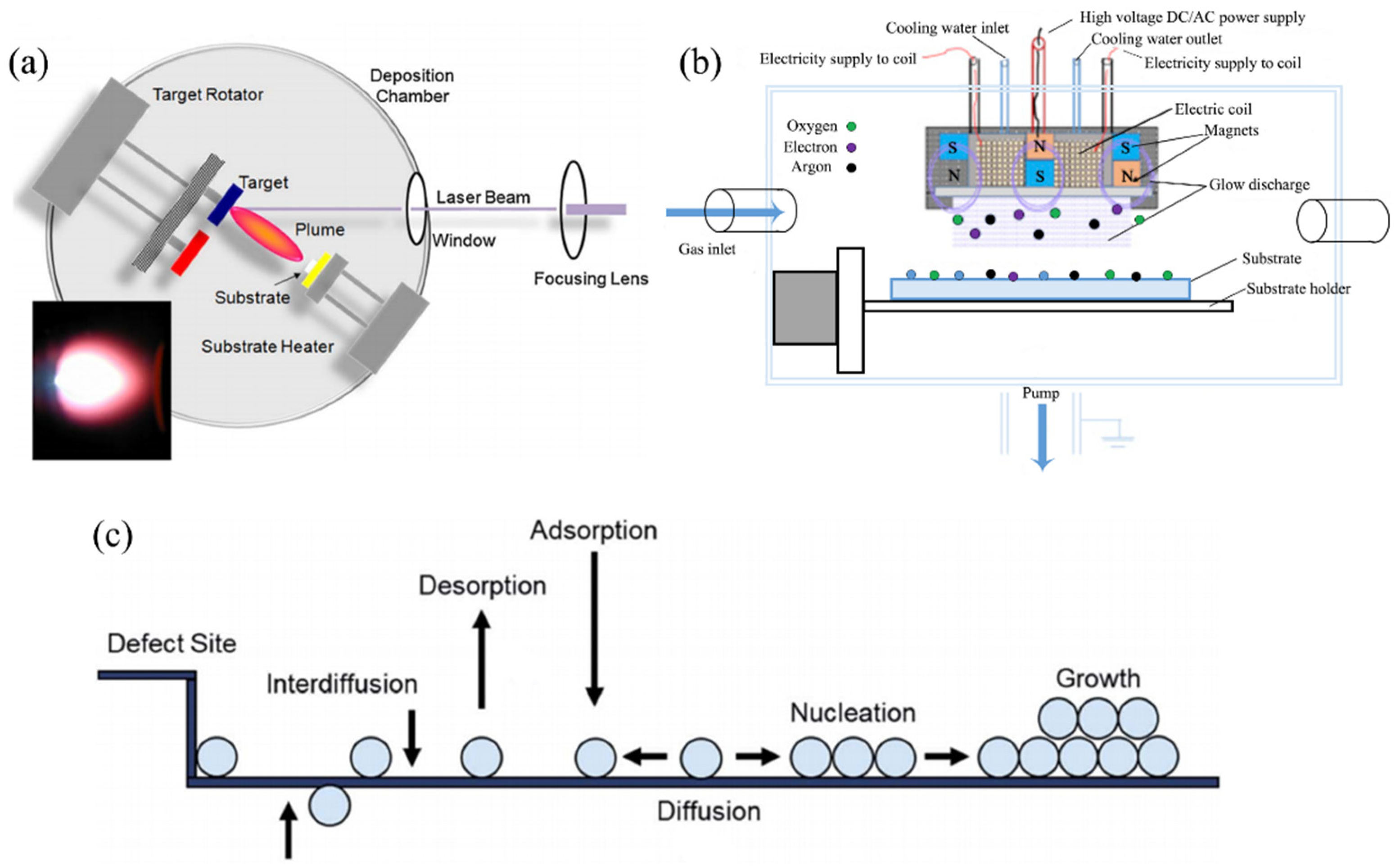
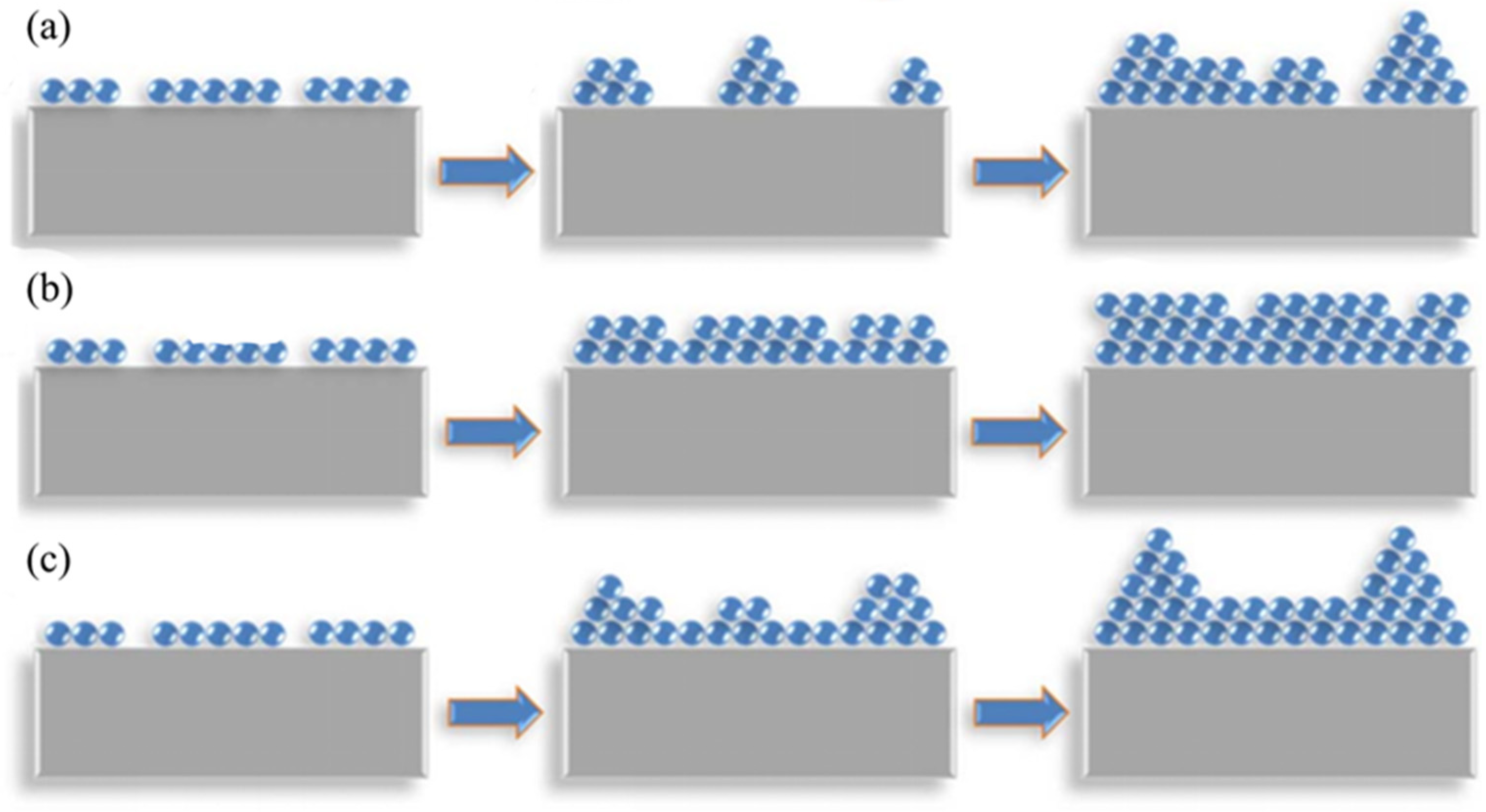


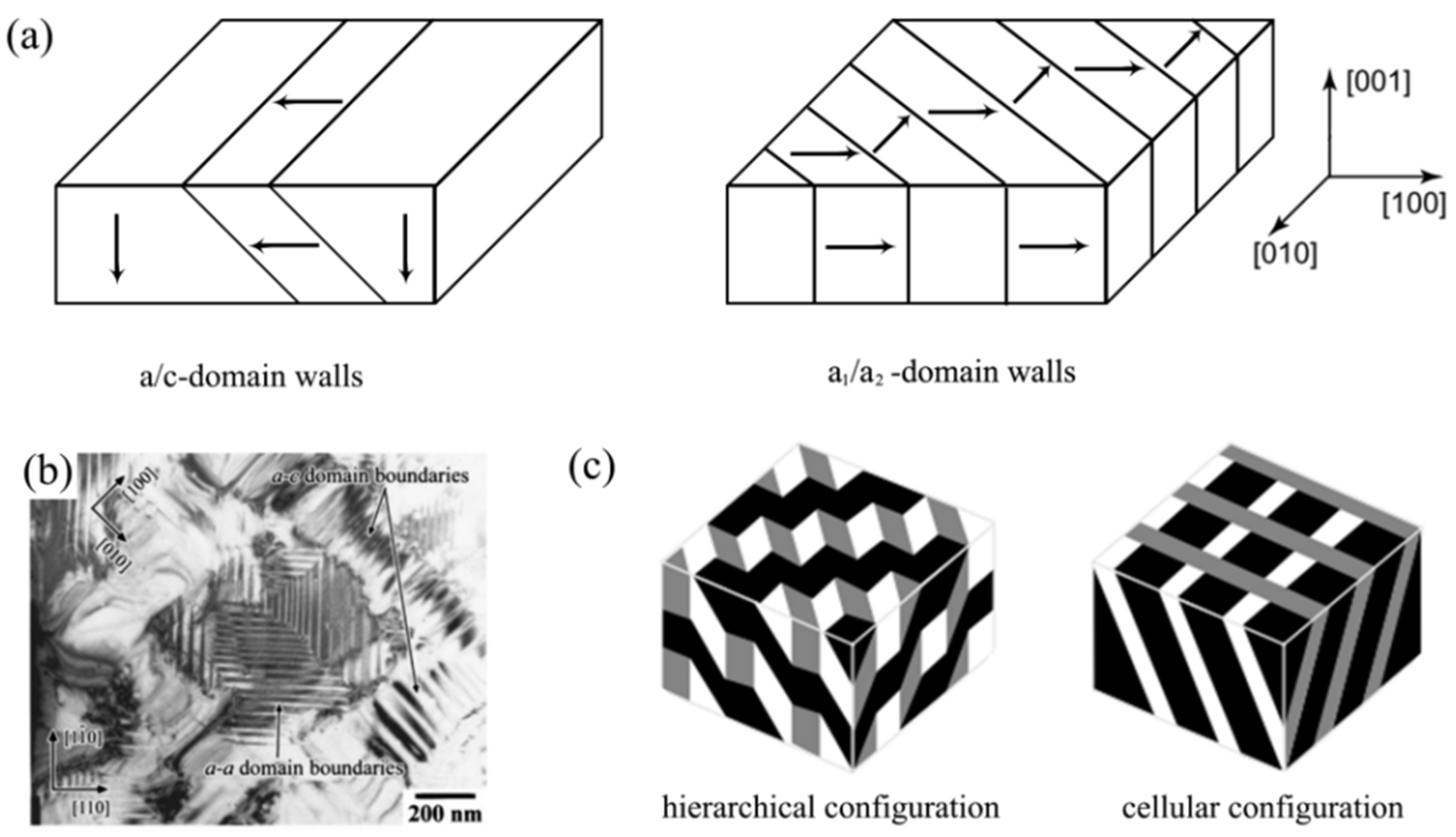
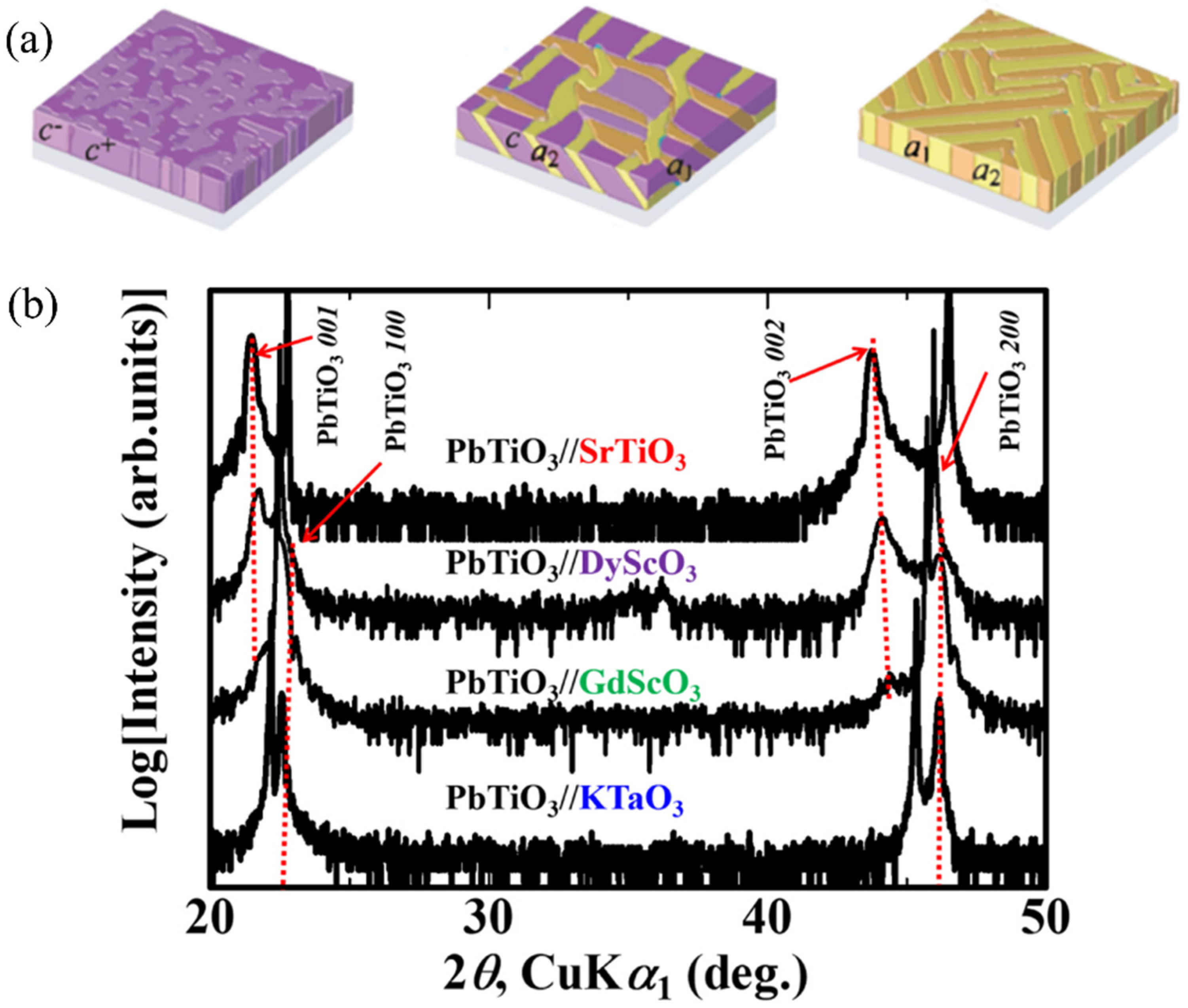


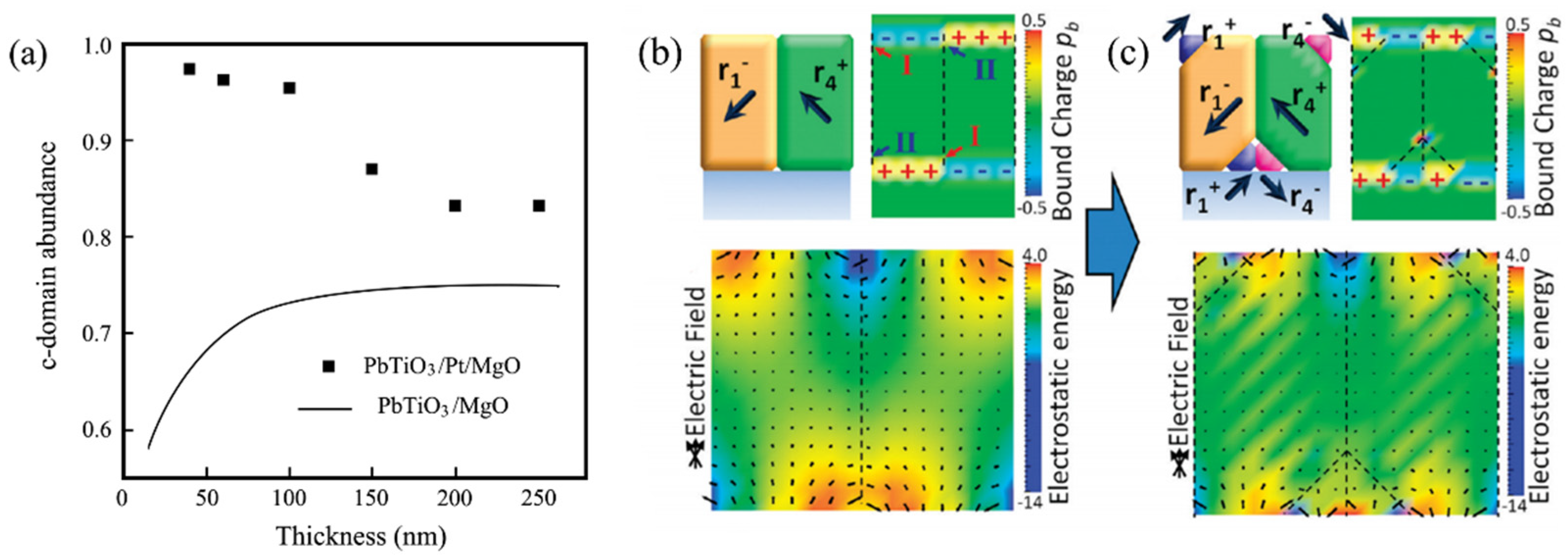
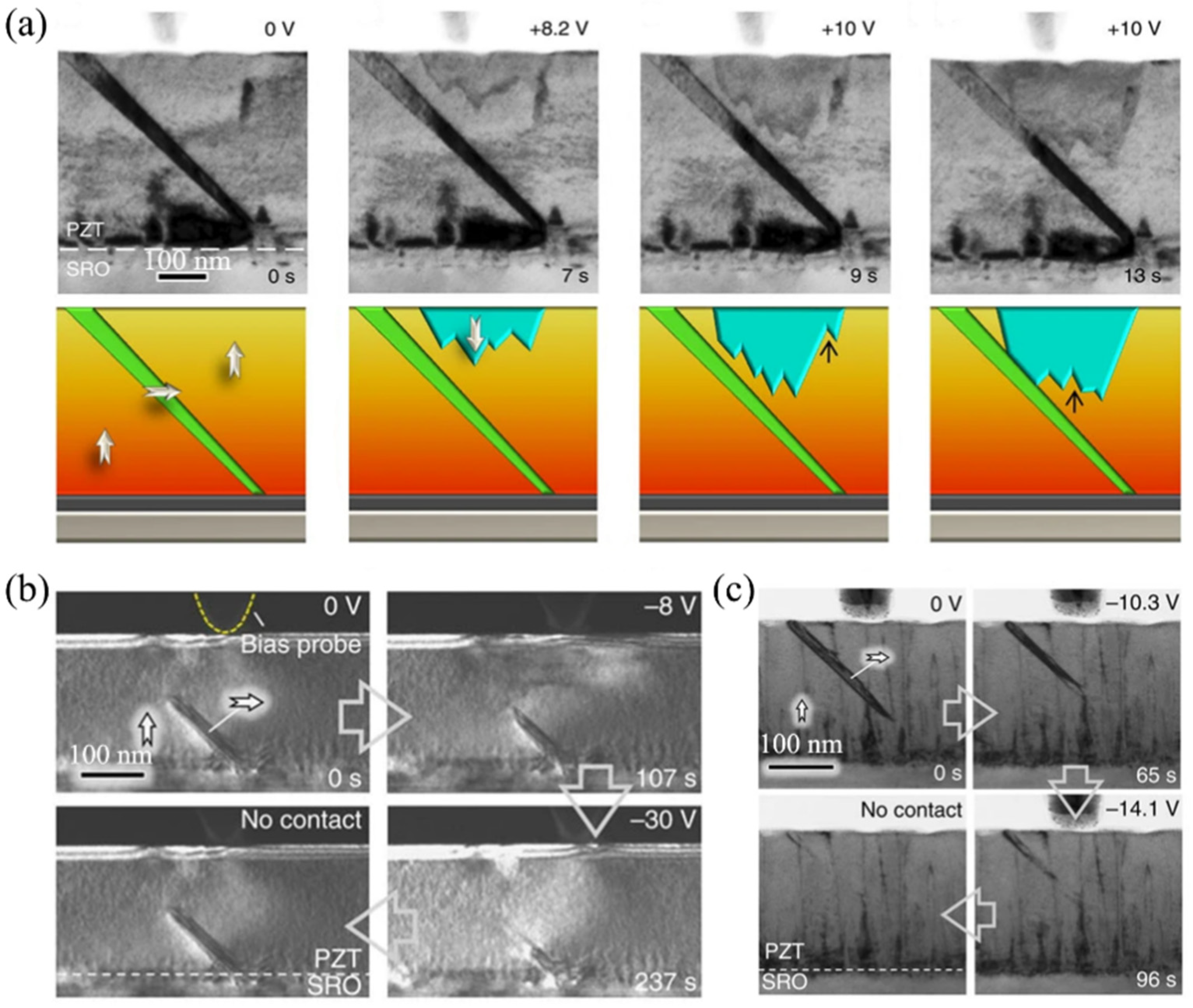

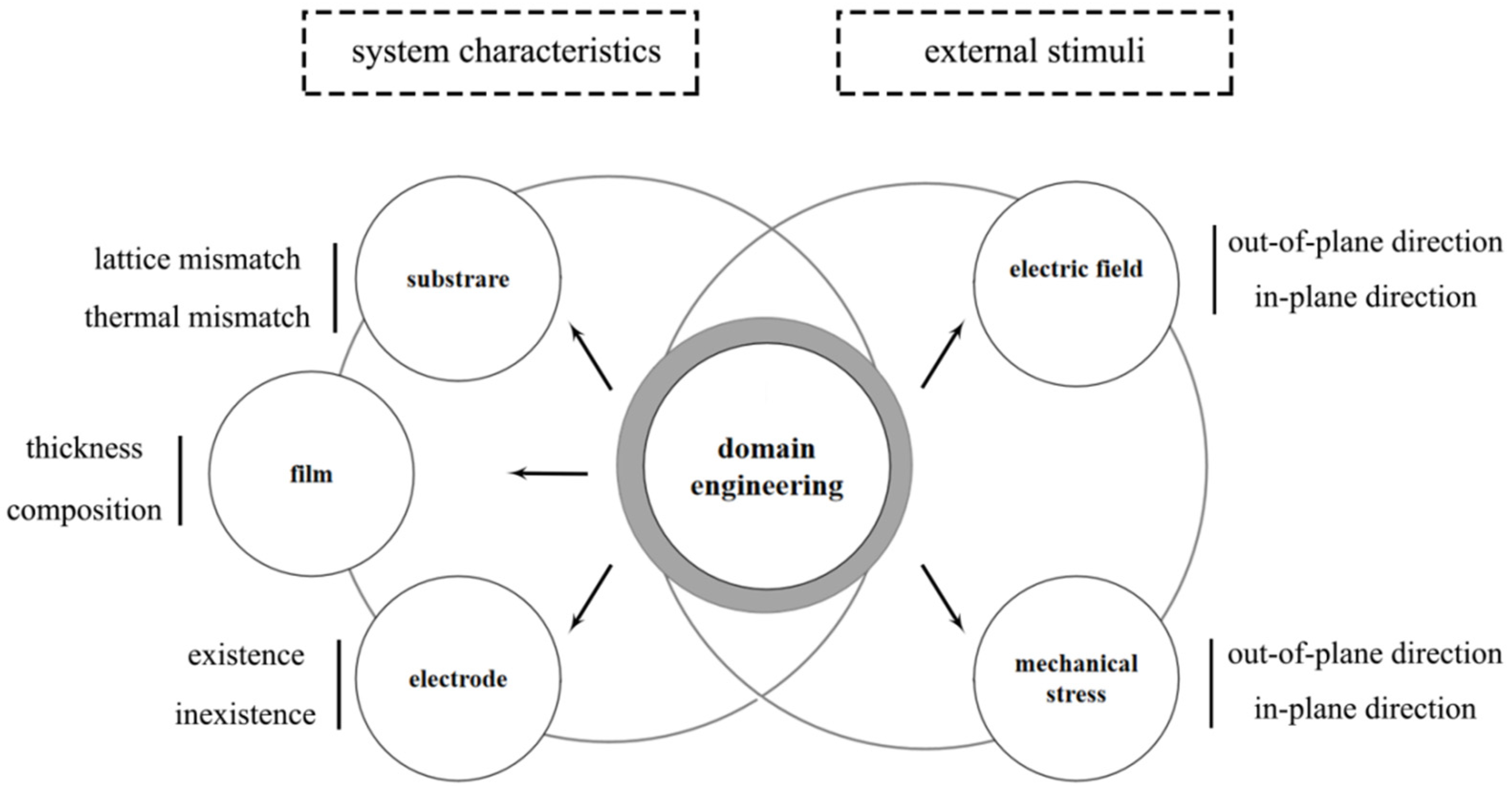
| Preparation Method | Mechanism | Main Process | Advantages | Drawbacks |
|---|---|---|---|---|
| Sol-gel | Colloid chemistry | A sol system is formed through a chemical reaction, and then a thin film is gelled on the surface of the substrate. | Low cost; controllable composition; | Uncontrollable chemical reaction; poor uniformity and bonding force |
| PVD | Physical method | Promote the transfer of atoms from a solid or molten source to the substrate by physical methods to form a thin film. | Uniformity and bonding; controllable thickness | High cost; low deposition rate |
| Domain Structure | Elastic Energy | Theoretical Equilibrium State |
|---|---|---|
| c-domain | ||
| a-domain | None | |
| a/c-domain | ||
| a1/a2-domain |
Publisher’s Note: MDPI stays neutral with regard to jurisdictional claims in published maps and institutional affiliations. |
© 2021 by the authors. Licensee MDPI, Basel, Switzerland. This article is an open access article distributed under the terms and conditions of the Creative Commons Attribution (CC BY) license (https://creativecommons.org/licenses/by/4.0/).
Share and Cite
Chen, C.; Song, J.; Zhang, Q.; Gong, M.; Liu, Y.; Fan, T. Ferroelectric and Ferroelastic Domain Related Formation and Influential Mechanisms of Vapor Deposited Piezoelectric Thin Films. Coatings 2021, 11, 1437. https://doi.org/10.3390/coatings11121437
Chen C, Song J, Zhang Q, Gong M, Liu Y, Fan T. Ferroelectric and Ferroelastic Domain Related Formation and Influential Mechanisms of Vapor Deposited Piezoelectric Thin Films. Coatings. 2021; 11(12):1437. https://doi.org/10.3390/coatings11121437
Chicago/Turabian StyleChen, Chu, Jian Song, Qi Zhang, Mingyu Gong, Yue Liu, and Tongxiang Fan. 2021. "Ferroelectric and Ferroelastic Domain Related Formation and Influential Mechanisms of Vapor Deposited Piezoelectric Thin Films" Coatings 11, no. 12: 1437. https://doi.org/10.3390/coatings11121437
APA StyleChen, C., Song, J., Zhang, Q., Gong, M., Liu, Y., & Fan, T. (2021). Ferroelectric and Ferroelastic Domain Related Formation and Influential Mechanisms of Vapor Deposited Piezoelectric Thin Films. Coatings, 11(12), 1437. https://doi.org/10.3390/coatings11121437









